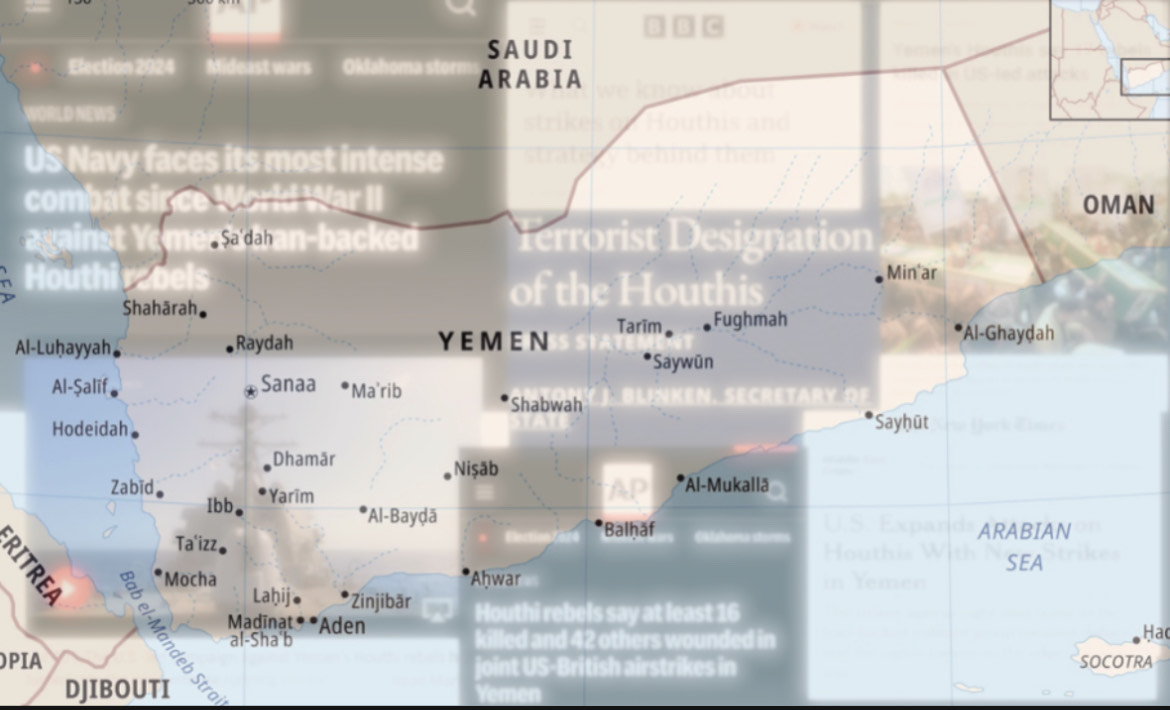With the escalation of the conflict between Israel and Hamas, more countries have gotten directly involved in combat, the most important ones being the United States and Iran. Iran, one of the strongest military powers in the Middle East, backs multiple terrorist organizations in neighboring countries such as the Houthi pirates in Yemen, Hezbollah in Lebanon, and Hamas in the Palestinian territories. The United States continues to support and fund the State of Israel despite increasing political polarization regarding foreign policy in the Middle East. The United States has recently started an open-ended campaign in the Red Sea. The goal: put a stop to the acts of piracy committed by Iran-backed Houthi rebels based in Yemen. As a result of this campaign, the United States has entered its most intense naval conflict since World War 2.
Other PawPrint articles have addressed the October 7th attack and the history of the conflict since 1947 as well as the Rafah Border invasion which marked Israel’s expansion of attacks beyond North and Central Gaza.
The Houthis, a Yemeni Shia-Muslim rebel group, recently declared a terrorist organization by the U.S., has a record of maritime piracy in the Red Sea. The group arose during the Yemeni Civil War in 2014 as a rebellion against the Sunni Muslim government. Since their creation, they have been utilizing their location near the Suez Canal to conduct acts of piracy against mostly Western-owned ships. Following the escalation of violence from the Israeli Defense Forces in occupied Palestinian territory, they have begun targeting the United States and Israeli ships in larger amounts. Between the time of Hamas’s October 7th attack and now, the group was responsible for over 130 attacks in the Red Sea. This severely impacted trade and resulted in cargo traffic along the Suez Canal dropping significantly; many companies had to switch trade routes, going completely around the southern tip of Africa to avoid these attacks. The disruption of these trade routes and their effect on the global economy gave the U.S. and UK motives to attack. On January 17th, Anthony Blinkin, U.S. Secretary of State announced that the Houthis will officially be regarded as a terrorist organization. Despite being similar, the crime of piracy and the crime of terrorism are done with entirely different motives. It raises questions about whether or not the Houthis are truly a terrorist organization as their actions are not done to inflict terror on the Western world but rather an attempt to stop the trade of weapons and items being sent to what they believe is an oppressive and violent regime. Blinkin stated that if the attacks on the Red Sea cease, their designation as a terrorist organization will be reconsidered.
Here is a timeline of some key events that have occurred in the US Navel conflict with the Houthi Pirates:
January 9 – The Houthis launch fire into international shipping lanes where dozens of merchant vehicles were located. The barrage included 18 attack drones, 2 cruise missiles, and a ballistic missile. They were shot down by 2 US destroyer ships and F-18 fighter jets[1].
January 11-12 – the United States and the United Kingdom, with support from Canada, Australia, Denmark, Bahrain, the Netherlands, and New Zealand, attacked Yemen via a series of airstrikes. More than 100 precision-guided missiles were launched at 28 Houthi Rebel sites [2]. The explosions happened in populated cities including the Capital Sanna, Hodeidah (the fourth largest city in Yemen), and Dhamar [3]. There were 72 reported strikes led by the U.S. that day with 5 Houthi member deaths and possible but not recorded civilian deaths[4].
January 16-20 – a series of smaller strikes led by the U.S. took place in the days following. On the 16th the U.S. carried out the third round of strikes targeting four Houthi ballistic missiles that posed a threat to U.S. trade ships[5]. On the 17th, the U.S. carried out the 4th round of strikes targeting 14 Houthi missiles that were loaded and ready to be fired [6]. On the 18th, another two ready-to-be-launched missiles were struck and destroyed [7]. Another three Houthi missiles were destroyed on the 19th after the U.S. sent strikes via fighter jets to Sanna at 6:45 pm [8]. One more missile, this time aimed at the Gulf of Aden, was struck[9]. The Gulf of Aden is another crucial route for the global economy that is currently disrupted by Houthi piracy. Attacks like these happened almost daily after this week. Information regarding the smaller scale attacks is reported by The United States Central Command.
January 22: The United States and the United Kingdom carried out a joint attack on eight Houthi sites, hitting multiple targets. A total of 18 strikes were fired by the U.S. and UK near Sanna[10]. The attacks targeted Houthi radar sites, drone/missile sites, and underground weapon/storage bunkers. These strikes, larger than the previous ones, signaled that the Biden Administration was carrying out a full open-ended campaign against the Houthis due to their attacks on commercial ships[11].
February 3 – The U.S. strikes 6 Houthi missiles at 7:20 pm [12]. At around 11:30 p.m. The U.S. and UK (with support from Australia, Bahrain, Canada, Denmark, the Netherlands, and New Zealand), conducted strikes against 36 Houthi targets at 13 locations near Sanna. Targets included multiple storage bunkers, missiles, missile systems, drone storage and control sites, radars, and helicopters[13].
February 9 – the US carried out seven strikes targeting Houthi unmanned surface vessels, mobile anti-ship cruise missiles, and a land attack cruise missile that posed a threat to ships in the Red Sea[14]. The Houthis reported that 17 of their fighters were killed in these actions[15].
February 24 – around 11:45 p.m., the US and UK carried out over a dozen airstrikes on 18 Houthi sites, marking their fourth joint strike operation. The strikes focused on underground weapons storage, missile depots, drones, air defense systems, radar installations, and a helicopter[17]. One civilian was killed and 8 others were injured[16].
March 23 – The Houthis launched missiles at a Chinese-owned ship, despite previously stating they would not attack Chinese vessels[18].
May 30 – The US and UK Armed Forces conducted strikes against 13 Houthi targets in Houthi-controlled areas of Yemen. US aircraft from the USS Dwight D. Eisenhower and other US warships carried out airstrikes against underground facilities, missile launchers, command and control sites, a Houthi ship, and other locations. The Royal Air Force also struck Hodeida and Houthi weapons infrastructure. The Houthis reported that civilian homes and the headquarters of Hodeida Radio were hit, acknowledging 16 deaths and 35 injuries, marking the highest death toll in the US and UK campaigns[19].
October 17 – The US military launches B-2 stealth bombers to target underground Houthi bunkers. 5 underground weapons storage facilities were destroyed. This is the first use of B-2 bombers in years and marks a key point in escalation from the US military[20].




Jess • Nov 14, 2024 at 1:53 pm
Thank you for this outstanding piece of work and information! It was incredibly well-written and researched.